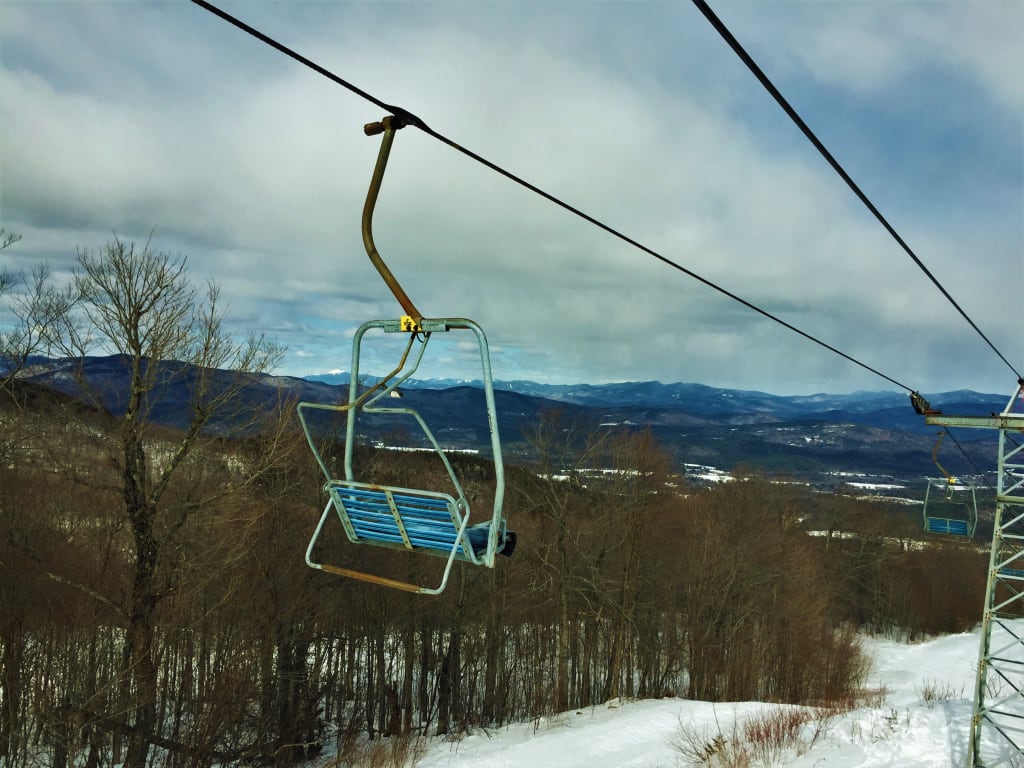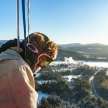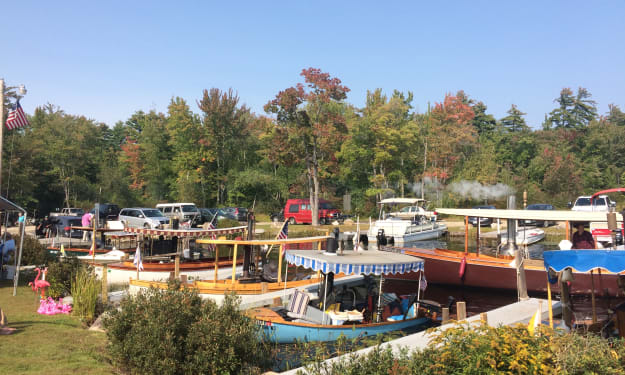Skiing Tenney
Rediscovering the Ghost Resort of the White Mountains

The old chairlift was empty as far as the eye could see. Though the weekend temps were comfortably into the 50s under blue skies, no skiers appeared on the slopes below us. We were skiing on a ghost mountain. In March of 2018, Tenney Mountain reopened on a whim eight years after bankruptcy and closure. Now, coming to the end of the month, a few dozen locals were rediscovering Plymouth’s forgotten ski hill.
Will, a childhood friend, had started working at Tenney in the fall of 2016. For months he welded together snowmaking pipes and cleared trails with the hopes of bringing the defunct mountain back online.
After some mid-winter momentum, those dreams were crushed in January 2017. Continually poor funding left the handful of employees out to dry and the mountain remained closed.
In the fall of 2017, Will returned to Tenney to raised eyebrows from his friends and family. Fool me once, shame on you. Fool me twice…but Will and a handful of other believers were persistent. They began to chip away at the monumental tasks and go through the certifications necessary to restart operations.
The real question is: why bother? Tenney is a modest-sized mountain with daunting limitations and steep competition. It’s 30 miles from Loon, 34 miles from Cannon, and less than 25 miles from Waterville Valley. What can Tenney offer as it stands today?
Tenney Mountain was opened by local enthusiasts in 1960. In 1964, a double chair gave access to over 1,200 vertical feet of terrain. Tenney would be the largest ski mountain in the area until the 1966 openings of Loon and Waterville. In the mid-1980s, the double chair was renovated to its existing condition, but was already passed out by high speed lifts at other local resorts.
Throughout its history, Tenney has always seemed a bit behind the times. The original founders of the mountain went bankrupt in an attempt to remain snowmaking-free. Lawsuits over lift installations resulted in entire seasons being lost to limited terrain offerings. Real estate development blunders resulted in foreclosure in 1990. A mountainside strip club brought unfavorable headlines in 1992. A failed rebrand resulted in closure in 1993. An attempt at year-round snowmaking in 2003 was disastrous. Time and time again, this little New Hampshire mountain couldn’t catch a break.
All across New England one can find the remains of ski mountains just like Tenney. Shaky finances, unlucky weather conditions, and local competition narrow the margin for success. Scenes of so many childhood memories and winter adventures are lost, and many never recover.
Despite its string of bad luck, one cannot say that Tenney has given up. Its failures over the years has made Plymouth no less a ski town. Though it may never be sustainable, the mountain continues to be desired by locals.
That became obvious when I first pulled into the parking lot at the end of March. Climbing out of my car, I gave a nod to the man pulling his skis out of the truck next to me. He must have been in his late 60s or early 70s and was grinning from ear to ear.
“Good day for it,” I said.
“I’m just glad to be back where I belong,” he said, and marched off to the lift.
The snow was all natural; a blessing from a batch of late season nor’easters. The trails were worn thin by the groomer and the lack of a base left rocks and dirt spots exposed. Off trail the snow remained unmarked. Perhaps a foot of powder, compressed to a thick soupy texture. It felt good to cruise through but also grippy, making tight turns sloppy and lethargic.
After taking a couple runs with me, Will had to return to the lift shack. He was one of two men on the mountain that actually knew the emergency stop procedures on the nearly 6,000 foot lift. Before going up for another run, he gave me suggestions for trails that I should try.
The first was a small glade on the gently sloped upper half of the mountain. The only direction he gave me was that it was on skier’s right and that I would see his tracks. When I saw a track heading down into the woods, I ducked a few boughs and trundled down into a world of shade and snow. This was a different kind of skiing. The turns were tight and it was all I could do to not rip myself in half on the fast coming trees.
I quickly discovered that I had left the trail too early and happened upon a thicket unfit for steady riding. After a minute of slow struggles, I dropped into a ravine, where the trees were wide and I was able to pick up more speed and control. I made it back to the groomed trail without injury.
Will’s next suggestion was a roped off trail about halfway down the mountain. Tote Road is a mellow blue square under normal ski conditions. It’s flat enough to catch the sun and I found the snow to be heavy with melt. A few rebels (most likely members of the skeleton ski patrol) had traversed this path already, leaving some areas packed down and some untouched. The inconsistency made for a bumpy ride.
About halfway down, a river of melt water carved the trail in two. Deep gullies—some a yard or more deep and twice as wide—exposed the rocky ground below. I did my best to keep up momentum as I jumped the gaps and bare spots. One wrong move and I would be lost in the endless mud pits. My form was far from beautiful, this was about survival.
By the time I got to the bottom my legs were screaming. I wasn’t just out of ski shape, I was out of shape period. Still, I took a bite on Will’s next suggestion, a closed black diamond way up in the ungroomed zone.
Here was a trail that had gone to seed during the years of closure. Eight year growth grew up thick on the edges of the trail and the skiable sections were filled with knee-high yearlings. If you pushed the speed, your skis wouldn’t get too caught up in them. However, once you got going, the saplings felt like riding crops slapping against your lower legs. Surfing through this mess wasn’t as technical as glade running nor as physical as Tote Road. It was fun finding the path of least resistance and charging the gaps at speed. By the time I got to the bottom I was exhausted, and took a break while Will finished up his work day.
One section that Will hadn’t yet explored was the old Engleswood Glade up in the northwest corner of Tenney. It was well out of the way, particularly with the thick new growth, but we were determined to find something raw to shred.
Will led the way until he found a suitable glade, far more spacious than the one I had tried earlier. Best of all, it was completely untapped. Will took a deep breath and dove right in. Under the shade of the trees, the compressed powder was higher than I expected and my turns were off balanced. I widened my stance and almost instantly lost control, missing a thick hardwood by inches. Will, who had gotten ahead of me, stopped to scout a path, and I slammed my shoulder into a tree in a sloppy attempt to stop.
“I can’t do anything in here,” I said, out of breath and amazed my skis had stayed on my feet.
“It’s tight,” Will conceded. “But you’ve got to hop turn, don’t just ride the back of your skis.”
Will set off again and I cleaned up my act, getting into a rhythm as I followed his trail through the woods. The glade continued to open up and was accented by the occasional, mellow ten foot steep. Getting more used to the muscle movements, I started to boldly push the pace and make my own tracks outside of Will’s. Dodging trunks and ducking boughs we made our way back towards civilization.
Will charges into the untapped Engleswood Glade in the far northern slope of Tenney Mountain.
We flew out of the trees into a tight thicket of eight year growth. Will got stuck, but I held my momentum in his wake before I realized I was heading right into his back at full speed. I threw my arms wide and got tangled up in a spectacular spasm of saplings and skis. Eventually we pushed our way through, back onto one of the closed off trails I’d tried earlier.
In recounting our path to one of the veteran ski patrollers, he revealed we’d only scratched the surface of Tenney’s glade offerings. The Engleswood Glade comprises acres of forest and added layers of seclusion to an already deserted mountain.
After taking one last cool-down run, Will and I were the last ones off the hill. Though I had been skeptical of Tenney before skiing it (another friend described it to me as “small” and “outdated”), after getting off the slopes I couldn’t help thinking that the place had potential. Maybe if they were able to tap into the local college scene… Perhaps if they hosted summer music festivals… Or the housing market picked back up again… Always there will be potential.
The reality is that whatever happens to Tenney, the people that love it will remain. There will always be old locals that know all the secret trails. If the lifts stop turning, they’ll still hike up to shred them. There will always be enthusiastic dreamers like Will. Even when the paychecks aren’t there, they’ll still invest the energy, time, and skills with the hope of building something worth remembering. Finally, there will always be skeptics like me that will actually have to feel that pounding in their chest before realizing how special this mountain could be.
###
About the Creator
Jordan Long
Jordan Long is a writer, pilot, and adventure enthusiast living in Phoenix, Arizona. He blogs about travel, hiking, skiing, flying, the arts, the environment, and everything in between.






Comments
There are no comments for this story
Be the first to respond and start the conversation.